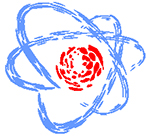Speaker
Mrs
Kamila Yegizbek
(Bakhtzhankyzy)
Description
Currently, intensive development of science and technology related to the manufacture of nanostructured materials. High interest in this area and its demand associated with unique properties that exhibit material on the nanometer scale. It was determined that ultra-small elementary material particles possess unique mechanical, optical, magnetic and electronic properties compared with the material of the same chemical composition but coarser structures. In this paper the synthesis of template used for the porous materials, in particular - track membranes, as a template, the surface pores which are deposited various metal nanostructures.
Electrochemical deposition of the electrolyte solutions was performed using track membranes based on the type Hostaphan® polyethyleneterephthalate manufactured by «Mitsubishi Polyester Film» (Germany) with a pore density of 4.0E + 07, 12 microns depth and a range of diameters from 180 to 380 nm. Irradiation of PET film produced on the DC-60 accelerator, krypton ions with energies 1,75MeV/nucleon. Electrodeposition in the tracks of the membrane was carried out at a voltage of 1.5V in potentiostatic mode. Electrolyte solution: NiSO4 × 6H2O (100,14 g/l), H3BO3 (45 g/l), С6H8O6 (1.5 g/l).
In this work, consider getting ordered arrays of nickel-based method of electrochemical deposition, the study of the structural features and electrical properties depending on the diameter of sample matrices far. To study the characteristics of the obtained Ni nanotubes were used methods of scanning electron microscope (SEM), transmission electron microscope (TEM), EDS, XRD.
Analysis of the scanning electron microscope (SEM) - images showed that the height of the nanotubes is equal to the thickness of 12 microns and diameters of the template pipe diameters are the patterned matrices. X-ray-defractometric study was conducted to identify the crystal structure of Ni nanotubes, which showed that the resulting single-phase samples have face-centered cubic structure with a lattice parameter different from the reference value. The radiometric data of the samples shows the results of calculations of average crystallite size by the Scherrer equation. EDS analysis of the spectra showed that the nanotubes are composed of 99.5% nickel, 0.5% of an impurity consistent with gold, which is used as a conductive layer, deposited on the matrix template before electrochemical deposition. X-ray-defractometric study showed that the resulting single-phase samples have face-centered cubic structure with a lattice parameter different from the reference value.
Author
Mrs
Kamila Yegizbek
(Bakhtzhankyzy)

